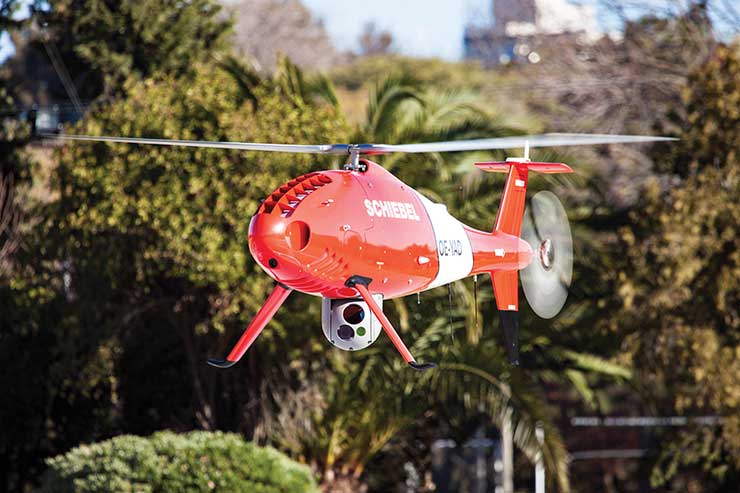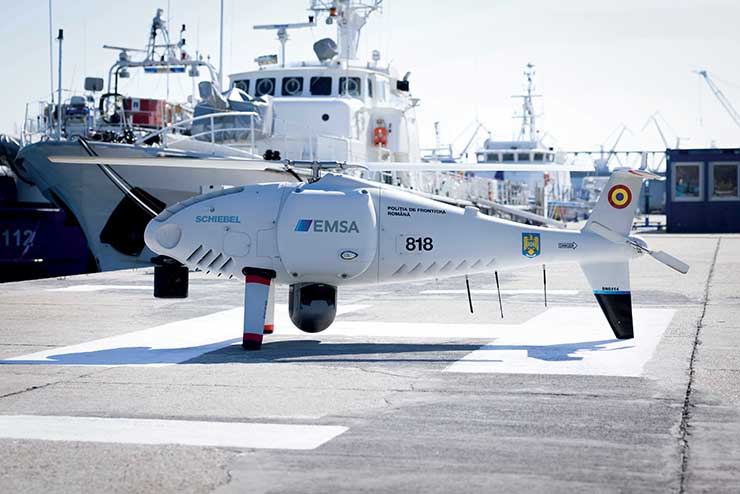
The globally operating company Schiebel Group focuses on the development, testing and production of the revolutionary CAMCOPTER® S-100 Unmanned Air System (UAS). The company has ended 2021 on a satisfactory note, as its Chairman and owner Hans-Georg Schiebel said, “there were several challenges, however though it is not business as usual it has sort of become the new normal.”
Founded in 1951 in Vienna, Schiebel has built an international reputation for producing high-tech military, commercial and humanitarian products. According to Michael Schiller, Schiebel’s head of programmes, the company dealt with the Covid-19 pandemic by “putting vigorous safety measures in place ranging from hygienic measures to wearing masks and partitions.” Due to these measures, the company does not encounter any delays in any of its production or delivery units.
The company has customers in five continents with a team of 300 dedicated professionals working across the globe in Austria, US, UAE and Australia.
The company follows a customer-centric approach, and offers various services to customers such as (a) customer support (b) technical support, and (c) quality support.
With the customer base of the company growing worldwide, it has plans to provide documentation service or the extended knowledge base free of cost to customers in the near future.
The company’s base in Wiener Neustadt was selected for its vicinity to the public airfield. Its building with a widely acclaimed design comprises both functional and spacious production facilities as well as ample office space for the growing number of staff members. Thus, the original concept of a high-tech setting for the series production of the design-awarded CAMCOPTER® S-100 has been perfectly implemented 50 km south of Vienna.
The highly visible landmark at the eastern edge of the Wiener Neustadt airfield epitomises the dual purpose of the building at first glance: varying façade material and structure composition clearly articulate the combination of a production hall and an office building.
The reflecting glass façade optically hides the ground floor as continuation of the surroundings in a mirror image. The protruding office wing behind a black basalt concrete façade seems to hover over the landscape. Expanding façade facilitates CAMCOPTER® air vents and deeply framed windows create clear perspectives.
With more than 2000 sq. metres floor space and its metal façade, the production hall underlines the technical aspect of the building project. Just like in a hangar, the hall can be opened through a wide door towards the airfield to support daily flight operations and training. Around the spacious hall, a training area, special workshops and a soundproof test room for the engine development are located. An elongated ramp leads to the main entrance of the office wing on the first floor provided with spacious offices and staff lounges. The adjacent conference room generously opens to a terrace used for receptions and as viewpoint for the nearby CAMCOPTER® presentations.
Schiebel’s CAMCOPTER® S-100 UAS has a proven usefulness for military and civilian applications. The Vertical Takeoff and Landing (VTOL) UAS needs no prepared area or supporting launch or recovery equipment. It operates day and night, under adverse weather conditions, with a range out to 200 km, both on land and at sea. The S-100 navigates automatically via pre-programmed GPS waypoints or can be operated directly with a pilot control unit.
Missions are planned and controlled via a simple point-and-click graphical user interface. High-definition payload imagery is transmitted to the control station in real time. Using “fly-by-wire” technology controlled by redundant flight computers, the UAV can complete its mission automatically in the most complex of electromagnetic environments. Its carbon fibre and titanium fuselage provides capacity for a wide range of payload / endurance combinations.

The S-100 has two different engines of 40 kgs and 44 kgs respectively and as company officials said in a recently-organised webinar offering a tour of the production line, “We develop them regularly and our teams work meticulously on them to test their capability in all conditions ranging from cold to hot temperatures. We also work very closely with our suppliers. The company is also working on further improving the supply chain.”
The company has also been working on providing UAVs for maritime reconnaissance considering that the Offshore Patrol Vessels (OPVs) are the fastest growing segment of the naval vessels with the total number of such vessels being used in 87 countries totalling 839.
Another area of focus of these S-100s is underwater surveillance in the maritime sector with the increasing number of submarines. The use of these unmanned aerial aircraft would enable nations to keep track of submarine movement as the S-100 has the capability to monitor underwater vessels.
The company is now working to develop larger copters weighing 500 kgs to 600 kgs called S-300. “We want to get the S-300 completely right before we enter the market,” officials said.
The company also provides a state-of-the-art Remotely Piloted Aircraft Systems (RPAS) that are fully certifiable in order to maintain technological advantage. It is partnering with the best technological providers and partners as and when needed for global, industrial and humanitarian use.
According to available figures, the VTOL UAS market continues to grow with reports suggesting it to have risen from US$408 million in 2019 to US$2.6 billion by 2030 at a CAGR of 19.7 per cent.
The company has been in business for almost 70 years. It has a very versatile range of products with multirole capability ranging from stationary deployment, mobile deployment, maritime operations and interoperatability.
Every year, Schiebel puts in more than 20 per cent of its revenue into R&D to stay on top and get even better. As the company Chairman said, “We are dedicated to the production of the unmanned helicopter CAMCOPTER® S-100. The journey has been tough and challenging with multiple ups and downs, and it has taken many years of hard work to achieve our goals.”








